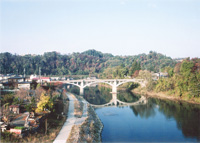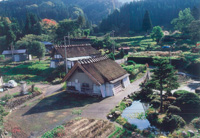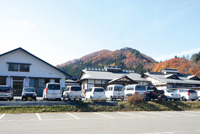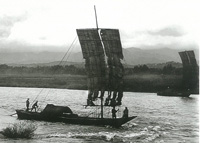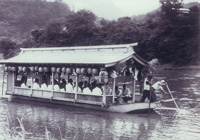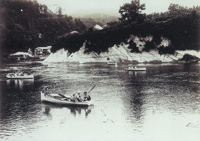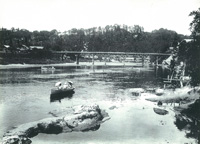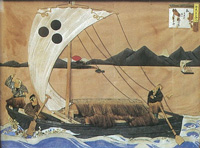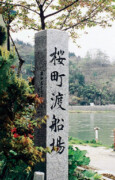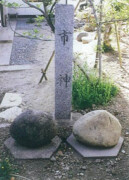
This is Oe Town
About Oe Town
Special importance is given to environment protection in this time of the 21st century. It is essential for us to treat wildlife with respect and raise awareness of the value of nature protection. This is also the time in which we put value on town history and everyday life which have been blessed and cultivated by the everlasting nature such as the magnificent Asahi Mountain Range, the Mogami River known as the “mother river,” and the Tsukinuno River with cherry salmon that inhabit its clear stream. Our mission is to hand down our culture co-existing with nature to coming generations. The local government and the town residents work together to develop a community where people live in harmony with nature, that will be achieved by following the current of the times, valuing the distinguishing features of the town, and always looking for a new and innovative approach to accomplish our goals.
Basic Information of Oe Town
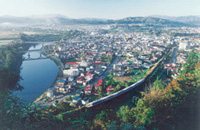
▲A view from Tateyama Park
Oe Town is located in the west side of Murayama Plain lying around the center of Yamagata Prefecture. The town geography is composed of abundant nature such as the Mogami River, one of the three fastest rivers in Japan to the east, Asahi Mountain Range which sits at the center of Bandai-Asahi National Park to the west, and the Tsukinuno River, connecting the two.
As an inland basin, the climate is classified as cold and snowy. Summer is characterized by high temperatures and humidity, accompanied by a foehn phenomenon which is common in a basin area. In winter, the snow season lasts long from early December through March or April. The snowfall amount reaches about one meter deep in the town center and two or three meters in the mountain region. Thanks to the drastic changes in temperature throughout a year, the town is blessed with an abundance of farm products, especially fruit and food from the mountains.
The town center is located to the east. Aterazawa (左沢 in Japanese character) is also known for its difficult to read characters. This area evolved into a riverside town as the Mogami River transport industry became a center of commerce and industry.
In the midland region, there are several excellent fruit farms dotted around the countryside, producing special local products such as La France pears, apples, and grapes.
The west area is located at the eastern foot of Bandai-Asahi National Park and many mountain lovers come to visit this base station. The area mainly relies on small-scale rice cultivation, forestry resources, edible wild plants, and mushrooms.
The Origin of the Town’s Name
The name of Oe Town was given by the then governor of Yamagata Prefecture, Tokichi Abiko, when it was registered as a town. He saw the Mogami River, which had brought many blessings to Okitama region (the south of Yamagata), and a number of streams in the mountain villages collect and bend before reaching the town, then finally form into Oe (described as 大江 in Japanese character, literary means “a great river”). In the hope that the town would develop eternally like the Mogami River, the town was named Oe by him.
The Origin of Aterazawa
The town center is in the area called “Aterazawa.”
History and Culture
Aterazawa in Oe Town had prospered as a river port of the Mogami River transport. The Mogami River shipping route was streamlined in the early Edo period. During that time, Aterazawa played an indispensable role as a relay point between Yonezawa and Sakata. Goods shipped from Yonezawa by Kokaibune was transshipped to Hiratabune at Aterazawa for shipping to Sakata. In the area around Domeki District on the riverside, there were Jinya (manor house) of Yonezawa Domain, storehouses for rice and salt, and Kuruwa (a red-light district) standing side-by-side, making the area busy and crowded. The hustle and bustle of this area continued until around the Taisho period.
The Mogami River contributed to the flourishing of the river transport culture that is typified by Kyoto’s elegant and graceful culture such as Dashi (a festival car) and Hina Dolls, by transporting those goods from Sakata. In the heyday of the town, a bustling market was held and many people visited this attractive commercial town.
The town keeps the old townscape with typically long and narrow townhouses which a frontage is approx. 6.5 meters and a depth is approx. 36 or 55 meters. Also, you will find Kura Zashiki (Kura-warehouse with family residence) and the site where once the guardian deity was enshrined in Haramachi Street. It reminds us of past glory days.
On March 27, 2013, “Landscape of Movements of Goods and People in Mogami River and the Aterazawa Townscape” was designated as an Important Cultural Landscape, a first for Yamagata prefecture.
The Song of the Mogami River Boatmen
The Mogami River boatmen had to leave their girlfriends or families over an extended period of time. Sometimes they had to row forward in raging rivers and put their lives at risk to protect their boat and cargo because any accidents might lead to tremendous damage to their business. From long ago, the boatmen had been singing with all their heart various songs while working on the river.
The number of songs was merged into one and arranged in contemporary style. That is the song of the Mogami River Boatmen which is considered as one of the three most famous boatmen songs in the world* and one of the famous traditional folk songs of Yamagata prefecture.
In an effort to hand down this traditional song in a proper manner and further increase its popularity, a national singing contest is held every year in Oe Town.
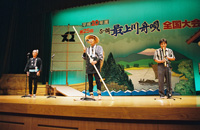
▲The song of the Mogami River Boatmen Singing National Contest
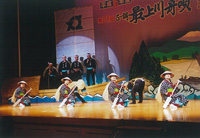
▲Song and dance performed at the singing contest
*The other two of the most famous boatmen songs in the world
Barcarolle from the Tales of Hoffmann
The song was written by Jacques Offenbach (1819-1880) who is famous as the composer of a comic opera “Orphée aux enfers.” “The Tales of Hoffman” is a grand opera based on three short stories by a German Romantic composer, E. T. A. Hoffmann. The opera consists of three tales of the protagonist Hoffmann in a flashback style. In Act 2, the scene is at the courtesan Giulietta’s luxurious mansion along the Grand Canal in Venice. A gondola floating on the canal is seen from the window. The duo performed by Giulietta and Nicklausse is renowned as a distinguished barcarole melody.
The Song of the Volga Boatmen
This is a traditional Russian song by an unknown composer. It was sung by barge-haulers with the lyrics mainly based on their self-encouragement “Ey, ukhnyem!” and “Ai-da, da ai-da.” There are various arrangements of the song. The version which is widely known today is the one sung by Feodor Chaliapin. Also, this piece has been used in classical music by Glazunov and Giordano.
Monument for the Song of the Boatmen
You can find stone monuments of the boatmen song throughout the town.
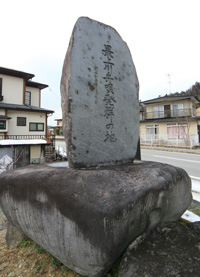
▲Stone monument for Domeki boatmen song

▲Stone monument for Tateyama boatmen song

▲Monument of honor for the boatmen songc




